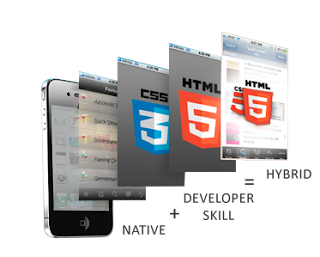Hybrid mobile app are created in the same way as websites. Both use a combination of technologies such as CSS, HTML and JavaScript. Nevertheless, rather than targeting a mobile browser, hybrid apps target a WebView hosted inside a native container. This allows them to do things such as access the hardware capacities of a mobile device. Hybrid apps could be found in the app stores. With them, one could play games, engage friends via social media, and take pictures, track health and a whole lot more.
WHAT EXACTLY ARE HBYRID APPS?
At core, hybrid apps are websites packaged into a native wrapper. They feel and look like a native application, but outside of the basic frame of the app, they’re fueled by the website of a company. A hybrid app basically is a web app built with the use of HTML5 and JavaScript, wrapped in native container that loads most of the information on a page as a user navigates through the app.

ADVANTAGES AND DISADVANTAGES OF HBYRID APPS?
ADVANTAGES:
1. Access to device data. Hybrid applications, similar to native apps could access data that devices pick up through functionality, like GPS and camera, but push notifications and address book information as well. Connecting with this functionality offers hybrid applications much more freedom to the kind of things they could do.
2. Easy scaling. The apps are also much easier to scale to different platforms and operating systems. The reason for this is that web technology is nearly 100 percent similar across various platforms and operating systems, to the could cod be reused simply without rebuilding the entire application from scratch.
3. Offline working. Due to their native infrastructure, hybrid apps could work offline. Although, while offline, obviously data could not be updated, users could still load the application and access data that’s previously loaded, unlike web applications. Data made while offline, whether captured through surveys, forms or any other way, could be stored on the device and sent to servers the moment a user connects to the internet.
4. More resources. Using web technology for application content makes hybrid application development much easier. Web technology knowledge far outstrips native coding, thus, there are a lot more resources and people available to deliver it. At the same time, costs and resources needed to code with web technologies are remarkably lower compared to native ones, so organizations could save money and time as well.
DISADVANTAGES:
1. Glitches. Another issue about hybrid and web apps is the way they render or load content. For instant, it is glitch, by loading various element of the app at different times. This is in contrast to the more polished and smoother native application user experience. Nonetheless, there are a lot of resources and solutions to fix the glitches.
2. Slower performance. Due to the content being based on web technology, hybrid applications could be slower to load compared to native apps. However, there are ways of managing this so it performs at its best.
3. Native vs. web components. A challenge to hybrid application developers is to make decisions wherein which components of applications must be native and which should be web-based. Obviously, this depends on every single application and its use, thus it’s something that every development team would have to individually decide.
4 Visual and interactive components. While visual and interactive components like 3D animations and games are available in hybrid applications, they still perform better on fully native applications. Nevertheless, hybrid apps performance is improving on a daily basis and getting closer to that of native applications.
THE MOST COST-EFFECTIVE WAY OF CREATING OPTIMAL MOBILE APPLICATIONS
Web applications and native applications seem to be very familiar, but they’re based on an entirely different infrastructure, both of which have their pros and their drawbacks. Hybrid applications now are letting developers take advantage of the benefits of both applications. While hybrid apps still pose some issues, developers are more and more coming up solutions to overcome them. Presently, the great benefits of hybrid apps make them the most cost effective ways to build optimal mobile applications and the differences in performance in comparison to native apps that are not that significant to warrant the extra efforts and cost.
WHY ENTERPRISE APPLICATIONS SHOULD BE HYBRID
There is an overflowing of databases on the internet regarding the merits and faults of native and web applications. Obviously, some favor the former while others favor the latter. While these applications are built on considerably different forms of technology, most people have no idea about the difference between them. To add to the confusion of the mix, there are things like hybrid apps that combine the elements of native and web technologies.
Ultimately, both technologies have their pros and cons. Nevertheless, it appears like hybrid would become the norm, at least in the enterprise level. As mentioned earlier, hybrid apps combine the power of both native and web apps. A hybrid app is like a native application with a browser embedded within. By combining the technologies, hybrid applications could take advantage of tall the native features of a native application, accessing data from other applications, ability to be downloaded form an app store, and offline working, while the actual content depends on HTML rendered in a browser.
Obviously, a hybrid app is a good choice if lacking in sufficient fund. Furthermore, even if the application will not be more customer-centered, hybrid application is good.
WHAT EXACTLY ARE HBYRID APPS?
At core, hybrid apps are websites packaged into a native wrapper. They feel and look like a native application, but outside of the basic frame of the app, they’re fueled by the website of a company. A hybrid app basically is a web app built with the use of HTML5 and JavaScript, wrapped in native container that loads most of the information on a page as a user navigates through the app.

ADVANTAGES AND DISADVANTAGES OF HBYRID APPS?
ADVANTAGES:
1. Access to device data. Hybrid applications, similar to native apps could access data that devices pick up through functionality, like GPS and camera, but push notifications and address book information as well. Connecting with this functionality offers hybrid applications much more freedom to the kind of things they could do.
2. Easy scaling. The apps are also much easier to scale to different platforms and operating systems. The reason for this is that web technology is nearly 100 percent similar across various platforms and operating systems, to the could cod be reused simply without rebuilding the entire application from scratch.
3. Offline working. Due to their native infrastructure, hybrid apps could work offline. Although, while offline, obviously data could not be updated, users could still load the application and access data that’s previously loaded, unlike web applications. Data made while offline, whether captured through surveys, forms or any other way, could be stored on the device and sent to servers the moment a user connects to the internet.
4. More resources. Using web technology for application content makes hybrid application development much easier. Web technology knowledge far outstrips native coding, thus, there are a lot more resources and people available to deliver it. At the same time, costs and resources needed to code with web technologies are remarkably lower compared to native ones, so organizations could save money and time as well.
DISADVANTAGES:
1. Glitches. Another issue about hybrid and web apps is the way they render or load content. For instant, it is glitch, by loading various element of the app at different times. This is in contrast to the more polished and smoother native application user experience. Nonetheless, there are a lot of resources and solutions to fix the glitches.
2. Slower performance. Due to the content being based on web technology, hybrid applications could be slower to load compared to native apps. However, there are ways of managing this so it performs at its best.
3. Native vs. web components. A challenge to hybrid application developers is to make decisions wherein which components of applications must be native and which should be web-based. Obviously, this depends on every single application and its use, thus it’s something that every development team would have to individually decide.
4 Visual and interactive components. While visual and interactive components like 3D animations and games are available in hybrid applications, they still perform better on fully native applications. Nevertheless, hybrid apps performance is improving on a daily basis and getting closer to that of native applications.
THE MOST COST-EFFECTIVE WAY OF CREATING OPTIMAL MOBILE APPLICATIONS
Web applications and native applications seem to be very familiar, but they’re based on an entirely different infrastructure, both of which have their pros and their drawbacks. Hybrid applications now are letting developers take advantage of the benefits of both applications. While hybrid apps still pose some issues, developers are more and more coming up solutions to overcome them. Presently, the great benefits of hybrid apps make them the most cost effective ways to build optimal mobile applications and the differences in performance in comparison to native apps that are not that significant to warrant the extra efforts and cost.
WHY ENTERPRISE APPLICATIONS SHOULD BE HYBRID
There is an overflowing of databases on the internet regarding the merits and faults of native and web applications. Obviously, some favor the former while others favor the latter. While these applications are built on considerably different forms of technology, most people have no idea about the difference between them. To add to the confusion of the mix, there are things like hybrid apps that combine the elements of native and web technologies.
Ultimately, both technologies have their pros and cons. Nevertheless, it appears like hybrid would become the norm, at least in the enterprise level. As mentioned earlier, hybrid apps combine the power of both native and web apps. A hybrid app is like a native application with a browser embedded within. By combining the technologies, hybrid applications could take advantage of tall the native features of a native application, accessing data from other applications, ability to be downloaded form an app store, and offline working, while the actual content depends on HTML rendered in a browser.
Obviously, a hybrid app is a good choice if lacking in sufficient fund. Furthermore, even if the application will not be more customer-centered, hybrid application is good.












